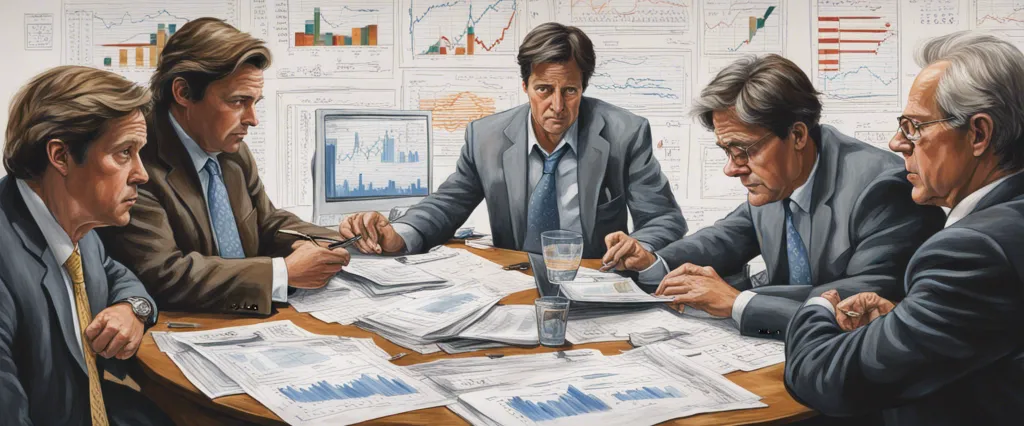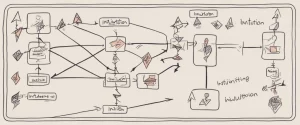
In an age of rapid global changes and financial complexities, exploring the inner workings of the economic world has become an intriguing endeavor. Amidst the vast array of books dissecting the financial landscape, two works stand out: “The Great Game” by John Steele Gordon and “The Big Short” by Michael Lewis. While both books delve into the intricate realm of finance, their perspectives and approaches differ substantially. In this comparative study, we will analyze these captivating narratives, highlighting the unique insights each author presents and examining the literary techniques they employ to captivate their readers. Through an exploration of the historical context, narrative structure, and storytelling techniques, we will endeavor to unearth the underlying threads connecting these two captivating works, ultimately discerning their respective contributions to our understanding of the complexities inherent in the financial world.
Brief Summary of Two Books
The Great Game by John Steele Gordon
“The Great Game” by John Steele Gordon explores the historical context and influence of economics in shaping America’s rise as a world power. The book takes readers on a journey through American history and analyzes pivotal moments that propelled the nation into becoming an economic powerhouse.
Gordon delves into various aspects of economic development, including the rise of industrialization, the impact of technology, the importance of entrepreneurship, and the crucial role of government policies. He highlights the economic factors that influenced key events like the American Revolution, the Civil War, the World Wars, and the Great Depression.
The author emphasizes the fundamental principles that guided America’s economic growth, such as free-market capitalism, individual liberty, and competition. He argues that these principles, combined with America’s vast resources and diverse population, created an environment conducive to innovation and progress.
Gordon also explores the challenges and setbacks that the American economy faced, including recessions, financial panics, and political obstacles. He provides insights into the strategies employed by presidents, lawmakers, and business leaders to overcome these challenges and promote economic growth.
“The Great Game” provides a comprehensive analysis of how economic factors have shaped America’s trajectory as a global superpower, with an emphasis on the role of innovation, entrepreneurship, and free markets. It offers readers an illuminating perspective on the historical dynamics between economics, politics, and societal development in the United States.
The Big Short by Michael Lewis
“The Big Short” by Michael Lewis is a non-fiction book that delves into the financial crisis of 2008. The book follows the stories of several key figures who foresaw the impending collapse of the subprime mortgage market and bet against it, ultimately profiting from the crisis.
Lewis begins by introducing us to Michael Burry, a hedge fund manager who first discovers the unsustainable nature of the housing market and starts investing in credit default swaps. He is soon joined by other characters such as Steve Eisman, an eccentric investor who sees the same signs of an impending disaster, and Greg Lippmann, a Deutsche Bank trader who helps spread the knowledge of the housing bubble.
As the narrative progresses, Lewis explains how Wall Street firms and banks were making a fortune by packaging and selling risky mortgage-backed securities while at the same time downplaying the inherent risk. These individuals, the “outsiders” who bet against the industry, face ridicule and skepticism from the financial community, which is blind to the impending collapse.
The book highlights the system’s flaws and the greed-fueled decisions that led to the financial crisis, exposing how complex financial instruments were creating a bubble that couldn’t be sustained. Despite their relentless pursuit of wealth and profit, the housing market becomes increasingly fragile, leading to the eventual collapse and subsequent global financial meltdown.
“The Big Short” is a thought-provoking account that sheds light on the few individuals who were able to profit from the crisis due to their foresight and contrarian thinking. It serves as a cautionary tale, reminding readers of the dangers of unchecked greed and the vital importance of questioning prevailing financial narratives.
Comparison between Two Books

Similarities in Financial Documentary
The Great Game by John Steele Gordon and The Big Short by Michael Lewis are both financial documentary books that delve into the world of finance, exploring intricate details, events, and characters that shaped the industry.
1. In-depth Analysis: Both books provide an in-depth analysis of the financial markets, closely examining significant events that occurred within a specific time frame. The Great Game primarily focuses on the history of Wall Street, while The Big Short offers an inside look into the 2008 financial crisis.
2. Character-driven Narratives: Both authors employ a character-driven narrative style, presenting real-life individuals who played crucial roles in the financial events they portray. These characters come from various backgrounds but share a common obsession with finance and its intricacies.
3. Exploration of Market Dynamics: Both texts explore the market dynamics and financial instruments that contributed to particular economic events. Whether it’s the development of hedge funds, subprime mortgage bonds, or credit default swaps, both books aim to explain complex financial concepts in a comprehensible manner.
4. Examination of Systemic Flaws: The authors critically examine the systemic flaws within the financial system. They outline how greed, unethical practices, and lack of oversight led to catastrophic consequences for the global economy. Both authors highlight the dark side of finance, exposing the vulnerabilities and dangers inherent in the industry.
5. Incorporation of Historical Context: These books place the financial events they cover within a broader historical context. The Great Game provides a historical overview of Wall Street since its inception, helping readers understand the evolution and growth of the industry. The Big Short focuses on the 2008 financial crisis, analyzing the historical factors that led to the collapse of the housing market and subsequent economic downturn.
6. Wide Appeal: Both books aim to captivate not only finance professionals but also the general public. The authors employ storytelling techniques to engage readers with little to no background in finance, making the subject matter accessible and compelling.
7. Implications for Society: Both texts highlight the wider implications of the financial events they discuss. They explore how the actions of a few individuals and institutions can have devastating consequences for the broader society, leading to job losses, foreclosures, and economic instability.
In summary, The Great Game by John Steele Gordon and The Big Short by Michael Lewis share several similarities as financial documentary books. They analyze financial events, employ character-driven narratives, explore complex market dynamics, critique systemic flaws, provide historical context, appeal to a wide audience, and discuss the societal implications of finance.
Divergences in Financial Documentary
The Great Game by John Steele Gordon and The Big Short by Michael Lewis are both financial documentaries that explore complex aspects of the financial world. While they share a similar topic, their approaches and perspectives differ, resulting in divergences in how they present their narratives and themes.
One key divergence lies in the overall tone and writing style of the two books. The Great Game, written by John Steele Gordon, takes a historical approach to financial episodes throughout American history. Gordon’s writing style is more academic, providing in-depth explanations and analysis of the events, aiming to educate readers on the topic. It delves into the historical context, giving readers a broader understanding of the financial system and its evolution.
On the other hand, The Big Short by Michael Lewis focuses on a specific event – the subprime mortgage crisis of the late 2000s. Lewis adopts a narrative approach, blending real-life characters and their experiences into the story, making it more character-driven. The writing style is more journalistic, with a focus on capturing the human stories behind the crisis. This approach creates a more immersive experience for the readers, allowing them to empathize with the individuals involved.
Another significant divergence between the two books is their central message or theme. In The Great Game, Gordon’s main focus is to provide an overview of American finance history and emphasize the cyclical nature of economic booms and busts. He argues that these cycles are inevitable due to human greed, irrational exuberance, and occasional fraud. The book aims to help readers understand that these financial crises are not uncommon occurrences but part of a larger pattern.
However, The Big Short, authored by Michael Lewis, focuses primarily on the 2008 subprime mortgage crisis and the individuals who were able to predict and profit from it. Lewis examines the flaws and corruption within the financial system that led to the crisis, exposing the reckless behavior of some bankers and the lack of regulation. The book highlights the systemic failures within the industry and the consequences that everyday people faced as a result.
In conclusion, while both The Great Game by John Steele Gordon and The Big Short by Michael Lewis address financial topics, they diverge in terms of writing style, tone, and central theme. The Great Game takes a historical and academic approach to educate readers about the broader patterns in the financial industry, while The Big Short adopts a more narrative and journalistic style to expose the specific events and players that led to the subprime mortgage crisis. By examining these divergences, readers can gain a more comprehensive understanding of the multifaceted nature of financial documentaries.

Conclusion
Both “The Great Game” by John Steele Gordon and “The Big Short” by Michael Lewis are highly regarded books in their respective genres.
“The Great Game” explores the history of Wall Street, providing a comprehensive overview of triumphs, scandals, and financial innovations that have shaped the American economy. It delves into the workings of the stock market, highlighting key players and events that have influenced its development. This book is ideal for readers interested in financial history and the mechanics of Wall Street.
On the other hand, “The Big Short” delves into the 2008 financial crisis and the individuals who successfully predicted and profited from it. Michael Lewis skillfully intertwines storytelling with complex financial concepts, making it accessible to a broader audience. The book offers insight into the causes and consequences of the crisis while highlighting the flaws and risks within the financial system. It is an excellent choice for readers seeking an engaging and informative analysis of the 2008 meltdown.
Ultimately, the decision on which book to read depends on your specific interests. If you are more inclined towards a comprehensive history of Wall Street, “The Great Game” would be the better choice. However, if you are looking for a gripping account of the 2008 financial crisis and its aftermath, “The Big Short” is highly recommended. Both books offer valuable insights and are worthy of reading.

